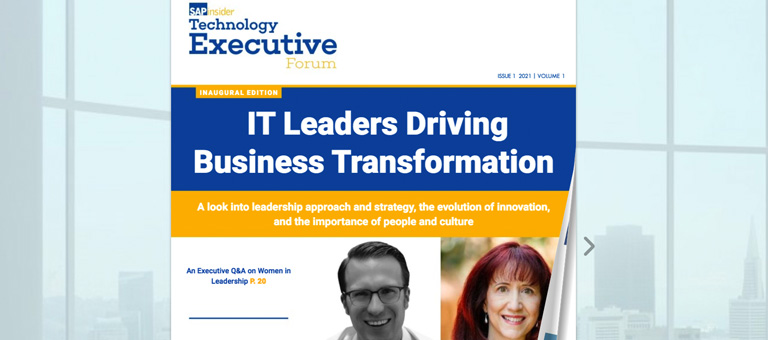Piecing Together a Successful Digital Transformation
Q&A with Adaire Fox-Martin, Executive Board Member, SAP Global Customer Operations
Q: Having come to SAP from Oracle and to the IT industry from public education, you have a somewhat untraditional background for an SAP executive. Could you describe your career path?
A: I grew up in Dublin, the oldest in a family of three girls. I went to Trinity College, and then worked as a teacher in the UK. At the time, Oracle was looking to hire teachers to provide training on relational databases and fourth-generation languages (4GLs). I was one of seven who went into this program. We were essentially given a computer science degree in this 4GL world.
This kind of professional education in IT provided me with an opportunity to learn about the products, the people, and their needs in great detail. I learned how to present a complex topic in a way that even the beginner in the classroom could understand.
I eventually taught 14 courses ranging from database design to database management to building applications. That was my step into this industry, and since then I’ve had the opportunity to fill a lot of incredibly challenging and exciting roles. I’ve actually worked across every single line of business in an IT company.
What’s interesting is that despite not having a computer science degree I was still given a fair opportunity. I sometimes wonder if we afford the same opportunity to people just starting out in their careers. My own career path is a testament to the fact that individuals with a unique and different profile can add value to a business.
Q: Now you have a big role in Global Customer Operations (GCO), and head Europe and Asia. Could you describe your responsibilities and focus?
A: What’s most important is that the focus remain on the customer. A year ago, when Jennifer Morgan and I started sharing the GCO portfolio, one of the discussions was about coming up with a new name for our board area. We were adamant that the word “customer” stay in the name. We have the opportunity to represent the customer at the SAP Executive Board, ensuring that everything we do is in service to our customers with an outside-in approach.
Regarding my regional role, there is such an incredible depth of relationship in Europe between SAP and our customers and it’s so longstanding. We are so ingrained in so many parts of our customers’ business here that we have an absolute duty of care toward them in terms of where their business is now, where this industry is now, and how we help bring those two pieces together and move them forward.
There are some aspects of life in Europe that are a little bit more complex to manage than in China: The General Data Protection Regulation (GDPR), privacy, consent, and the ability to use data is a prime example. All these things can differ country by country across the EU, which makes using data as the engine oil for your business much more complex in Europe than it is for a Chinese company.
It’s been interesting to examine the differences between the markets, but one thing that my experience has taught me so far is that the SAP story resonates equally in Japan, India, Austria, and the Nordics. Even if you are in an emerging market or a mature market, some of the fundamental challenges of business remain the same. And SAP can help to address those.
Q: How do various regions adopt cloud and SAP HANA differently?
A: Cloud offers — particularly small to medium-sized enterprises (SMEs) — a lower cost of entry into enterprise-grade software. For small businesses this means that you can now run your business in the same way that a large enterprise could at an entry cost that is ratable to your use of the software. I think that’s very exciting. Cloud can be a great leveler in terms of enterprise software and the ability of organizations to have access to that kind of business capability in a way that is affordable and meaningful to them.
With the breathtaking speed of innovation in China, and the country now home to some of the largest tech companies in the world, the potential for cloud adoption is massive. In 2016 in its 13th Five-Year Plan, the Chinese government made cloud one of its strategic priorities. However, we have to remember that the market in China is much more differentiated than in Europe — you have these giant state-owned companies, large traditional companies, multinational corporations, new companies that are digital-only or Internet-based, and a huge SME market as well.
Each adopts cloud differently. The state-owned companies are relying on private cloud; here we’ve been very successful with SAP HANA Enterprise Cloud, SAP S/4HANA, and on-premise software. The big Chinese corporates are exploring hybrid models, whereas the new entrants on the market and companies in fast-moving industries are rapidly adopting public cloud technologies, but the platforms need to be China-based. SMEs are also looking at public cloud.
The SAP story resonates equally in Japan, India, Austria, and the Nordics. Even if you are in an emerging market or a mature market, some of the fundamental challenges of business remain the same. And SAP can help to address those.
– Adaire Fox-Martin
As I said, in Europe, we have companies with these very mature relationships with SAP. For example, a few weeks ago I met with board members of a large manufacturer based in Europe. An executive showed us a schema of the company’s technical environment and architecture to support its production process. Then he overlaid on that model where SAP software plays in its system. SAP software touched every part of its system (the production line and the supply chain). You could see the depth of SAP software in its business, creating unique and differentiating business processes. Over the years, it has added or extended its system, or we have added industry footprints used by this company.
It is our role to help companies like this consider how they move to the cloud. I have been driving this topic with my team and my Board colleagues at SAP. We’re creating a specific value proposition for our customers to help them transform, using all the industry insights from our 8,900 SAP S/4HANA customers, our wide customer base, and over 45 years of deep industry experience.
Q: What effect does the public cloud have on SAP’s development and go to market?
A: In the world of on-premise software, we might have come out of the box at 85% ready, and then the business would rely on system integrators to do the rest. Now with public cloud, you’ve got to come out of the box 99.9% ready. Customers accept that SAP provides standard processes in the cloud. And, if they have processes that are unique or very highly differentiated, they can build extensions — their own intellectual property — on SAP Cloud Platform and connect to the SAP portfolio. So public cloud changes not only the way SAP develops and goes to market, but it also changes the way we work with customers and partners, and how they work with each other. By building their own apps on SAP Cloud Platform, customers gain more flexibility and can create innovation that is unique to them.
Q: Are organizations changing the way they support and buy software?
A: I’m seeing CIOs emerge again after a period of being sidelined as line-of-business owners purchased software-as-a-service (SaaS) solutions independently of the IT departments. Organizations have come to realize that data drives business process and business process generally extends beyond specific line-of-business solutions. That’s why I think the concept of the intelligent enterprise is important on two fronts.
At SAP we are integrating all our products so that they become a modular suite. If you want finance and HR, you can choose these two things as a service. Or you may choose to have one on premise or one in the cloud. It’s a modular approach, and they’ll integrate. This is what customers want — consumption choice and an integrated business process.
Embedded in that application will be the intelligence of technologies like artificial intelligence (AI) and blockchain so that not only will you have an integrated suite of applications that can compete on their own in a best-of-breed world, but they also integrate key business processes end to end. Embedded in those are all the latest technologies in which you are technologically current. We’ve already embedded 11 machine learning algorithms into the next-generation ERP core, others currently in development, and a range of processes ready to move into the development cycle. The application itself becomes intelligent, but it is integrated at your choice with the other modules in the portfolio.
If we go back to my example of the manufacturer, you’d have to have a very strong business case to justify the move to the cloud just from a purely technical basis. A greater return is required. That’s something that we’re super cognizant of. We now need to take the remainder of our installed base on this journey, but we need to do it in a value-oriented way. Questions that people ask are in the context of business — that is, what is the business case? And how do we get from where we are now to where we want to be?
We have to help our customers answer the why (the business case and the business value) and then the how. Everybody’s “how” is different, so it needs to be a personalized journey map for that customer.
Q: What else would you like SAPinsider readers to know about you?
A: As a Board member and a person, I’ve always been very focused on outcome. My industry background is in the public sector, and in the public sector, if you paint a vision, you need to deliver on the vision. I’m very conscious of that sense of ownership that we have for our customers and their outcomes. I would like them to know that at the Board level, and across SAP, there are a lot of people who care deeply about our customers’ success.









